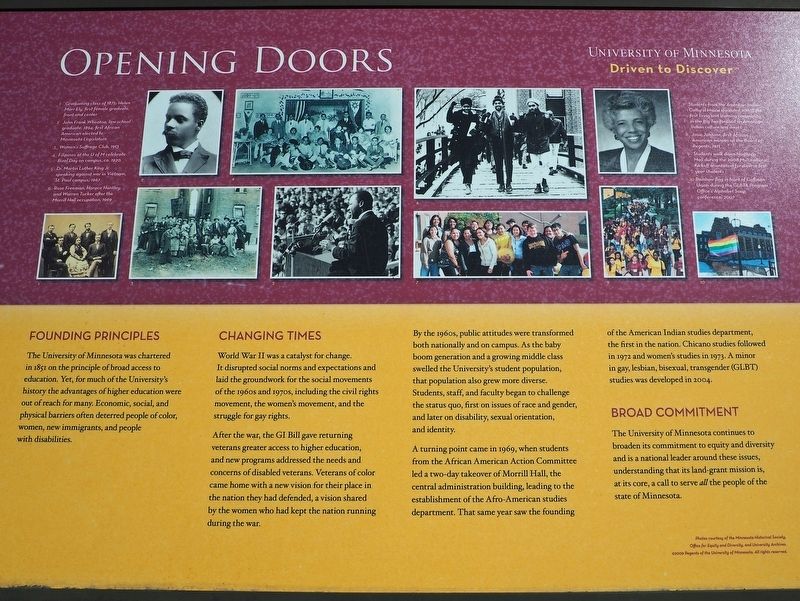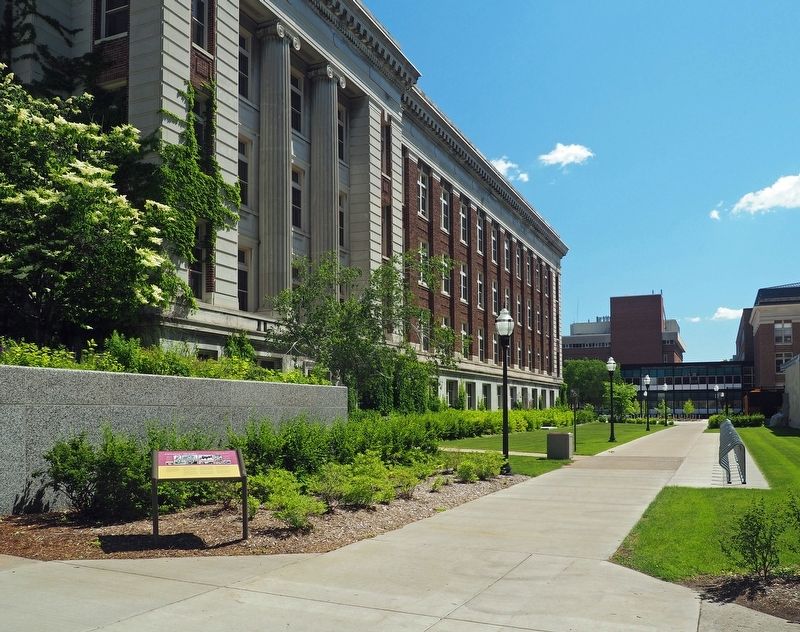University in Minneapolis in Hennepin County, Minnesota — The American Midwest (Upper Plains)
Opening Doors
Driven to Discover
— University of Minnesota —
Founding Principles
The University of Minnesota was chartered in 1851 on the principle of broad access to education. Yet, for much of the University's history the advantages of higher education were out of reach for many. Economic, social, and physical barriers often deterred people of color, women, new immigrants, and people with disabilities.
Changing Times
World War II was a catalyst for change. It disrupted social norms and expectations and laid the groundwork for the social movements of the 1960s and 1970s, including the civil rights movement, the women's movement, and the struggle for gay rights.
After the war, the GI Bill gave returning veterans greater access to higher education, and new programs addressed the needs and concerns of disabled veterans. Veterans of color came home with a new vision for their place in the nation they had defended, a vision shared by the women who had kept the nation running during the war.
By the 1960s, public attitudes were transformed both nationally and on campus. As the baby boom generation and a growing middle class swelled the University's student population, that population also grew more diverse. Students, staff, and faculty began to challenge the status quo, first on issues of race and gender, and later on disability, sexual orientation, and identity.
A turning point came in 1969, when students from the African American Action Committee led a two-day takeover of Morrill Hall, the central administration building, leading to the establishment of the Afro-American studies department. That same year saw the founding of the American Indian studies department, the first in the nation. Chicano studies followed in 1972 and women's studies in 1973. A minor in gay, lesbian, bisexual, transgender (GLBT) studies was developed in 2004.
Broad Commitment
The University of Minnesota continues to broaden its commitment to equity and diversity and is a national leader around these issues, understanding that its land-grant mission is, at its core, a call to serve all the people of the state of Minnesota.
Photo captions
1. Graduation class of 1875: Helen Marr Ely, first female graduate, front and center
2. John Frank Wheaton, law school graduate, 1984; first African American elected to Minnesota Legislature
3. Women's Suffrage Club, 1913
4. Filipinos at the U of M celebrate Rizal Day on campus, ca. 1920
5. Dr. Martin Luther King Jr. speaking against war in Vietnam, St. Paul campus, 1967
6. Rose Freeman, Horace Huntley, and Warren Tucker after the Morrill Hall occupation, 1969
7. Studentsfrom the American Indian Cultural House (founded 2003); the first living and learning community in the Big Ten focused on American Indian culture and issues
8. Josie Johnson, first African American woman on the Board of Regents, 1971
9. Students walk down Northrop Mall during the 2008 Multicultural Kickoff orientation for diverse first-year students
10. Rainbow flag in front of Coffman Union during the GLBTA Program Office's Alphabet Soup conference, 2007
Erected 2009 by Regents of the University of Minnesota.
Topics and series. This historical marker is listed in these topic lists: African Americans • Education • Native Americans • Women. In addition, it is included in the Martin Luther King, Jr. series list. A significant historical year for this entry is 1875.
Location. 44° 58.542′ N, 93° 14.097′ W. Marker is in Minneapolis, Minnesota, in Hennepin County. It is in University. Marker can be reached from Scholars Walk, 0.1 miles west of Church Street SE, on the right when traveling west. Located on Northrup Mall on the East Bank campus of the University of Minnesota, at the southwest corner of Morrill Hall. Touch for map. Marker is at or near this postal address: 100 Church St SE, Minneapolis MN 55455, United States of America. Touch for directions.
Other nearby markers. At least 8 other markers are within walking distance of this marker. Campus Design (a few steps from this marker); The Liberal Arts (within shouting distance of this marker); Spanning the Sciences (about 300 feet away, measured in a direct line); Continuing Education (about 600 feet away); Spanish-American War Memorial (about 800 feet away); The Armory Building / Military Training at the University (approx. 0.2 miles away); University of Minnesota Spanish-American War Memorial (approx. 0.2 miles away); Coffman Memorial Union (approx. 0.2 miles away). Touch for a list and map of all markers in Minneapolis.
Additional keywords. LGBT, LGBTQ, 🏳️🌈
Credits. This page was last revised on April 24, 2024. It was originally submitted on September 20, 2020, by McGhiever of Minneapolis, Minnesota. This page has been viewed 147 times since then and 17 times this year. Photos: 1, 2. submitted on September 20, 2020, by McGhiever of Minneapolis, Minnesota. • Devry Becker Jones was the editor who published this page.

